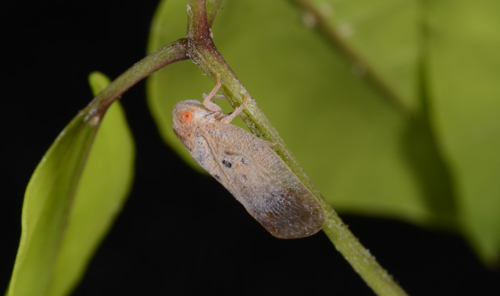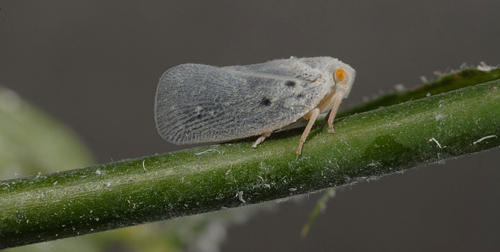common name: West Indian flatid planthopper
scientific name: Melormenis basalis (Walker 1851) (Insecta: Hemiptera: Flatidae)
Introduction - Distribution - Description - Life History - Hosts - Survey and Detection - Control - Selected References
Introduction (Back to Top)
West Indian flatid planthopper (Melormenis basalis (Walker 1851)) (Fig.1) was found in Florida for the first time in Miami-Dade County in 1997 by Florida Department of Agriculture and Consumer Services, Division of Plant Industry (DPI) inspector James R. Martin. The species was known previously only from Puerto Rico and the Leeward Islands (Fennah 1965) and Hawaii (Florida State Collection of Arthropods (FSCA) specimens from 1988). This species is established in southern Florida and now is known from Broward, Palm Beach, Martin, Collier, Hendry and Lee counties. There is no record from Monroe County, but the species presumably occurs there. The species is known to DPI inspectors as the "Puerto Rican planthopper."
Figure 1. Melormenis basalis (Walker). Photography by Lyle J. Buss, University of Florida.
There is some confusion surrounding the scientific name of this bug. Originally, it was described as Cicada quadripunctata Fabricius 1794; however, Kirkaldy (1909) discovered that there was another species with the same name: Cicada quadripunctata De Villers 1789, and De Villers' (1789) use of the name predates Fabricius (1794). By 1909, the genus had become Ormenis, but the problem in the original genus (Cicada) rendered the species name quadripunctata invalid. Thus, Kirkaldy (1909) proposed a new name, Melormenis antillarum Kirkaldy for the bug (Metcalfe 1957, p 329-332). Later, it was discovered by Fennah (1965) that Melormenis antillarum was the same insect as Flatoides basalis Walker 1851. Walker's (1851) name predates Kirkaldy's (1909), so the correct name became Melormenis basalis (Walker 1851). To further confuse the issue, there was also a Melormenis basalis Caldwell 1951, also from Puerto Rico. It was moved to the genus Capistra, also by Fennah (1965). Since the move of Caldwell's Melormenis basalis to Capistra precedes the transfer of Walker's Flatoides basalis to Melormenis (by half a page of text!), there is no homonym problem according to Fennah (1965), but also see comments by Bartlett (2014).
Distribution (Back to Top)
This species is known currently from Puerto Rico, the Leeward Islands of the Caribbean Lesser Antilles, Florida and Hawaii (Bartlett 2014; Bourgoin 2014).
Description (Back to Top)
West Indian flatid planthoppers are about 6 mm long. They are brown, with a dusting of gray wax.
They look quite similar to Metcalfa pruinosa (Say), but the spots on the wing are different (Fig. 2). In Metcalfa pruinosa, the spots form a triangle, and the clavus is free of spots (Mead 1969, republished 2004). The spots on the wing of Melormenis basalis form a line, and the top spot is on the clavus (Fig. 1).
Figure 2. Metcalfa pruinosa (Say). Photography by Lyle J. Buss, University of Florida.
Life History (Back to Top)
West Indian flatid planthoppers complete their life cycle on various plants. Nymphs are arrowhead-shaped and covered with wax. As is characteristic of flatid planthoppers, the posterior end of the nymph has large wax glands that produce tufts of wax that protrude from the back of the insect. Mixed colonies with other species of flatid planthoppers are common, so diagnosis of the nymphs can be problematic.
Hosts (Back to Top)
West Indian flatid planthoppers have a wide host range, especially as adults. Fennah (1965) reported only Acacia sp. (Fabaceae) and Coccoloba uvifera (L.) L. (Polygonaceae) as hosts, but in Florida we have found immature stages of the insects on Chrysobalanus icaco (L.) L. (Chrysobalanaceae), Eugenia uniflora (Myrtaceae), and Podranea ricasoliana (Tanfani) Sprague (Bignoniaceae), and we have hand collected adult specimens from 32 other plant species, representing 20 plant families in total. Adults were collected from several crop plants, including cotton (Gossypium sp.), citrus (Citrus spp.), mango (Mangifera indica L.), fig (Ficus carica Linnaeus, Sp. Pl. 1059. 1753), papaya (Carica papaya Linnaeus, Sp. Pl. 1036. 1753), and mustard (Brassica juncea (L.) Czern.). The species is recorded from coffee (Coffea arabica L.) in Hawaii (Fukada and Jones 2011).
Survey and Detection (Back to Top)
West Indian flatid planthoppers are found on the stems of many different plants. Often the colonies are surrounded by white wax produced by the insects. No damage has been observed except the wax and some honeydew and accompanying sooty mold. Adults of this species also are common on sticky boards used for fruit fly trapping.
Control (Back to Top)
Consult local University of Florida Extension offices for control of West Indian flatid planthoppers. In most cases, control will not be needed. This species is not known to transmit any plant pathogens, but no transmission testing has been done.
Selected References (Back to Top)
- Bartlett CR. 2014. Planthoppers of North America.University of Delaware. (accessed 2014 July 23).
- Bourgoin TH. 2014. FLOW (Fulgoromorpha Lists on The Web): A world knowledge base dedicated to
Fulgoromorpha. Version 8, updated 22 July 2014. (accessed 2014 July 23).
- De Villers C. 1789. Caroli Linnaei Entomologia, faunae Suecicae descriptionibus aucta : DD. Scopoli, Geoffroy, de Geer, Fabricii, Schrank, & c., speciebus vel in systemate non enumeratis, vel nuperrime detectis, vel speciebus Galli australis locupletata, generum specierumque rariorum iconibus ornata; curante & augente Carolo de Villers, Acad. Lugd. Maffil, Villa-Fr. Rhotum. necnon Geometriae Regio Profefiore. Tomus Primus, Sumptibus Piestre et. (accessed 2014 July 23).
- Fabricius JC. 1794. Entomologia systematica emendata et aucta: Secundun classes, ordines, genera, species, adjectis synonimis, locis, observationibus, descriptionibus / Joh. Christ. Fabricii. Impensis Christ. Gottl., Hafniae
(Copenhagen). 472 p., page 30. (accessed 2014 July 23).
- Fennah RG. 1965. New species of Fulgoroidea (Homoptera) from the West Indies. Transactions of the Royal Entomological Society of London 117(4): 95-125.
- Fukada MT, Jones VP. 2011. Crop Knowledge Master: Coffee insects. University of Hawaii. (accessed 2014 July 23).
- Kirkaldy GW. 1909. Hemiptera new and old. No. 1. Canadian Entomologist 41: 30-34. (accessed 2014 July 23).
- Mead FW. 1969, republished 2004. Citrus flatid planthopper, Metcalfa pruninosa (Say) (Homoptera: Flatidae).
Florida Department of Agriculture and Consumer Services, Division of Plant Industry Entomology Circular 85; republished as University of Florida, Featured Creatures. EENY 325. (accessed 2014 July 23).
- Metcalf ZP. 1957. Part 13. Flatidae and Hypochthonellidae. In: Metcalf Z. P. 1954. General Catalogue of the Homoptera. Fascicule IV. North Carolina State College, Raleigh, N.C., USA. p. 1-565.
- Walker F. 1851. List of the specimens of homopterous insects in the collection of the British Museum. London, Printed by order of the Trustees, 1850-52: 419. (accessed 2014 July 23).

